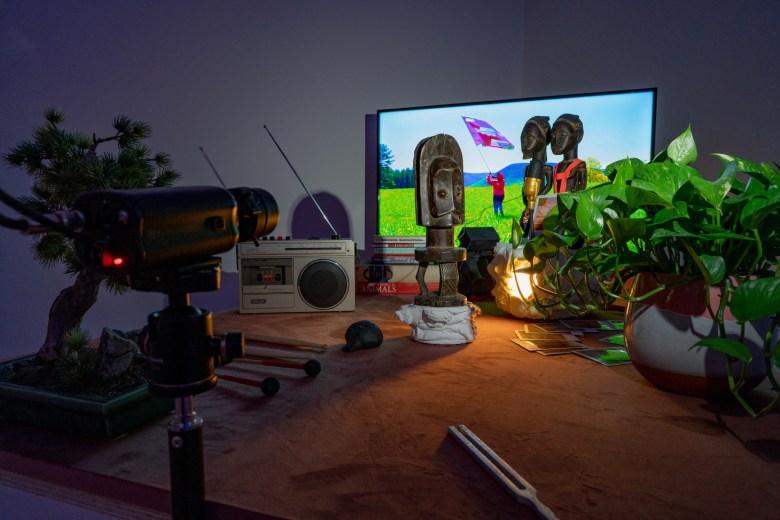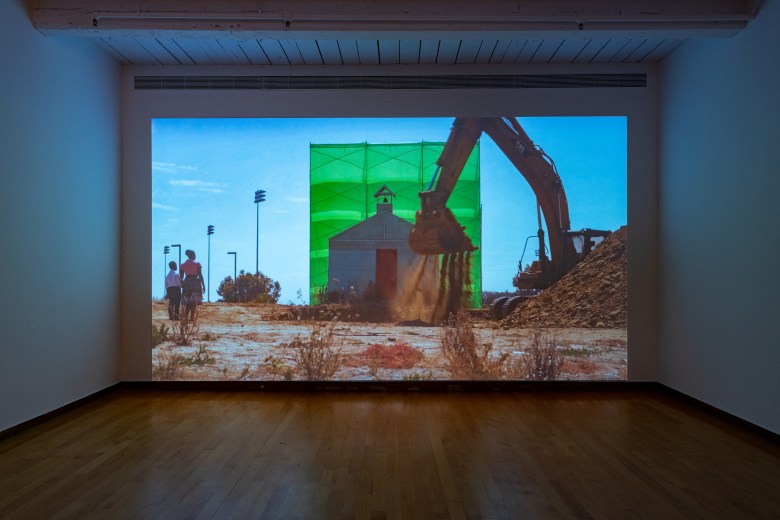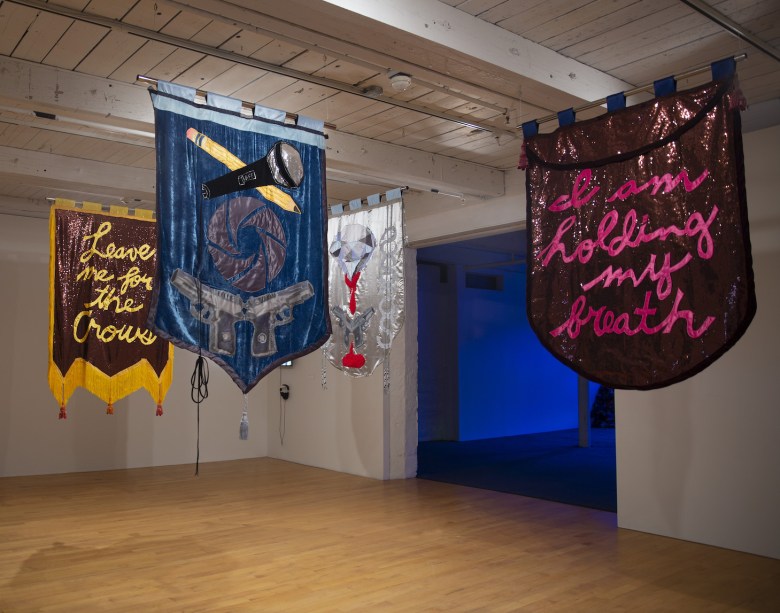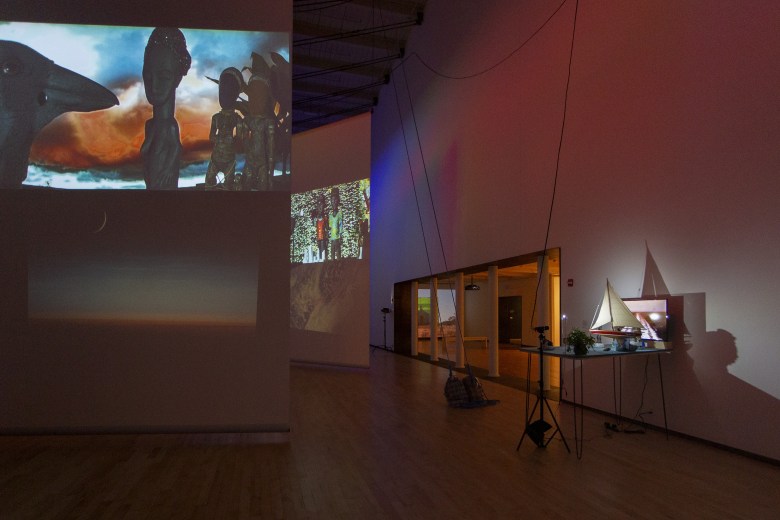
- Source: Hyperallergic
- Author: Olivia Gauthier
- Date: October 3, 2019
- Format: Digital
Cauleen Smith on Spirituality, Staging, and Having Enough
Discussing her solo show at MASS MoCA, the interdisciplinary artist explained, “When I’m talking about ‘We Already Have What We Need,’ what I’m really trying to talk about is our anxiety as human beings about how to live.”

Installation view of Cauleen Smith: We Already Have What We Need at Mass MoCA (all images courtesy Mass MoCA)
For the past few decades interdisciplinary artist Cauleen Smith has been making films, installations, and objects that at their core are rooted in the imaginary possibilities of the moving image to propose alternate futures. Smith’s works are informed by histories of film and music, particularly those of Third Cinema, Structuralist Film, and Jazz. She melds aesthetic and aural strategies associated with these movements and styles with influences from sci-fi literature, Afrofuturism, as well as alternative religious groups like the Shakers, adding a quasi-spiritual element to her works, which purport the existence of alternate realities while remaining firmly rooted in the contemporary. Smith culls from numerous sources to create her films, often staging group actions she calls processions, such as the one held during the 2017 Whitney Biennial in which a group of people gathered to walk through the museum’s neighborhood holding Smith’s banners from her series In The Wake, singing a gospel song as a collective act of both reconciling with and mourning the lost lives of Black people due to state-sanctioned violence in America.
Currently, her work is the subject of a comprehensive solo exhibition at MASS MoCA, “We Already Have What We Need” which for the first time brings together a selection of Smith’s works from her earliest films made in graduate school to a new multi-media installation. After the opening, I met Smith in her Los Angeles studio to discuss her upcoming procession, her relationship to spirituality, religion, and activism, and how she sees her job as an artist in the current cultural climate.
Hyperallergic: What are your plans for the procession for MASS MoCA?
Cauleen Smith: It’s a city parade that happens every year [in] North Adams to celebrate Autumn. I had an idea about making these incense burners which also have colored smoke that has a scent. The idea is the smoke bomb will be simultaneously threatening but also healing, the smell is cleansing but the orange and red and purple smoke would be kind of an alarm. These incense burners’s fundamental form is based off of ancient Greek smokers and I added anthropomorphic elements to them. They are actually frightening.

From “H-E-L-L-O” (2015), dir. Cauleen Smith (image courtesy of MASS MoCA)
H: So these will be carried in the procession?
CS: Yes, and the performers will all be wearing aprons over their uniforms made of these different fabrics. A Chicago based choreographer, Anna Martine Whitehead will teach my volunteer fire carriers some choreography along with a flag color guard. And LA-based musician Jeff Parker will compose this piece for the marching band which will be a weird vacillation between the theme from Close Encounters of the Third Kind and the theme from The Wizard of Oz.
H: I just don’t associate you with objects as often. So it’s interesting to see the burners and hear you talk about them.
CS: Yeah, with the incense burners, because of how they had to be made, you have to really finesse this clay; there’s a lot more content within them. I had a lot of failures and the other ceramicists told me it was because I was using this clay, Cassius [Basaltic], that is difficult to work with and causes problems with glazes, etc. And it was interesting the way they were talking about this clay — which fires black — is not so different from the way Black people are framed as a problem and I started to really like the idea of using this very difficult material to make the burners, which come from an idea of my relationship to the east coast where I really don’t feel so comfortable.
All of North America has to deal with how it was colonized but there’s something particular about the original 13 colonies, so I was already thinking about atonement and acknowledging harm as a way to move forward and progress. I was thinking about how to make a thing or event that suggests more than entertainment or protest but atonement which is a very serious thing that has to be done before apologies can even be made.

Installation view of Cauleen Smith: We Already Have What We Need at MASS MoCA
H: Your relationship to religion and spirituality is very interesting. Here you’re referencing back to ancient Greece, pre-Christianity. You seem critical of religion yet you have a precarious relationship [to it].
CS: Yeah it is a question that’s been coming up more poignantly for me as well, like are you religious or secretly spiritual? And I guess the way I think about this is that I am looking for tactics and strategies that bring people together in a way in which they can work towards something, and religion is a good model for that, but there’s other things like the military. The thing I am interested in most is the way that these organizations can produce thought and actions that can be shared as an individual or with others, and that is really the foundation of sociality. Right now in the United States, we are living in a really anti-social culture. Anything in which people have to cooperate I am interested in, but the reason what I am doing is art and not religion is that there is no dogma and the assumption is anyone who comes to the work will bring with them their own associations and set of tools for understanding the work.
H: You transform acts we might recognize, like a procession, and collapse and confuse these signifiers so that viewers have to actively decipher what your message is.
CS: Right, and I’m interested in the ways people come together but I’m not interested in then controlling what they do, which is where my relationship to activism comes in. I’m not asking for those who participate in my work to go out and do something specific — which is very serious work and needs to happen — but I think my job is much more about using those tools to produce enough instability to reflect on your emotions and associations to the incense burners or the marching band for instance.

From Cauleen Smith: We Already Have What We Need at MASS MoCA (installation view)
H: I like that you say your job. I think people turn to artists like you when questioning what the role of activism is in art. How do you see yourself in that dialogue? A lot of the language used around your work references generosity and radical community organizing, but what does that actually mean to you?
CS: I’m glad that that’s the way it’s experienced. If someone thinks that the work is generous, that’s good. If I’m demanding that someone look at my work and pay attention to it, there has to be a kind of reciprocity in the sense that I am asking. To me, activism is not an appealing thing to combine with art, because I think that they do very different things. Activists are generally trying to gain power so that they can affect policy, which actually produces real change in society. This is very important and very serious work and everybody has to show up for that in whatever way they can. The most precious sort of experiences I’ve ever had with art have been deeply personal and almost something that I can’t articulate and has destabilized me or shook me in such a way that I spent more time thinking about it. And I don’t think religion does that either, it tells you what to do. I’m interested in the opportunity for an individual to have some kind of experience that allows them to align themselves with something in the world that they’re aspiring to be.
H: When working on the show and seeing earlier works in dialogue with more recent works, what was that experience like for you?
CL: For me, that was the most gratifying thing and it didn’t really come together in my mind until it was installed and I was finally walking around and there was a graduate thesis film right next door to some very recent object work that isn’t even a film. It’s been really great for me to sort of see all these connections between how it was working when I was working in that very traditional form versus now and understanding that I’m still working through the same things.

From Cauleen Smith: We Already Have What We Need at MASS MoCA (installation view)
H: And you made a new work for the show at MASS MoCA?
CL: Yeah, it’s called “We Already Have What We Need.” It’s a collection of video screens that are hoisted up by pulleys up to the ceiling and weighted down by carrier bags, the kind you find at dollar stores; I associate them with immigration. Those are the weights that hold the sails up in the sky, and then underneath the video projections are just still slides that are all kinds of aerial photographs of the planet itself or of constellations. It gets very macro. I feel like each table is populated by random objects, like an incense burner, a feather, a book, some dice, a bottle of prescription pills, a statue of a cat, it’s super granular, like a cosmological question. When I’m talking about “We Already Have What We Need,” what I’m really trying to talk about is our anxiety as human beings about how to live. We have so much anxiety about it, that we tend to hoard and accumulate and in doing so, we do a lot of harm. And that hoarding and accumulating also results in famine. There is enough. There’s already right now enough for everyone.
Cauleen Smith: We Already Have What We Need continues at Mass MoCA through April 2020. The exhibition was curated by Susan Cross.

